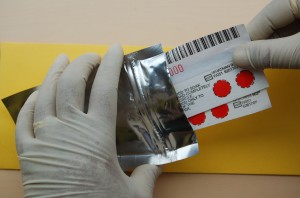More sensitive analytical technologies allow medical laboratories to perform more sophisticated tests using tiny blood specimens on paper
New breakthroughs are creating the opportunity to use “dried blood spot” (DBS) technology in an expanded number of pathology and clinical laboratory testing applications. The latest innovation was developed in the United Kingdom and allows more sophisticated applications of this decades-old screening method.
This new technology was announced in a press release that discussed the new screening method. It was developed by a research team in the UK as a rapid method for simultaneously screening patients for a range of genetic and acquired clinical conditions from a single dried blood spot.
The team consisted of researchers at King’s College of London, together with clinicians from Guy’s and St. Thomas’ NHS Foundation Trust. The college and the two hospitals are part of King’s Health Partners, one of the UK’s five Academic Health Sciences Centers.
New Tool for Pathologists to Screen for Diabetes and Kidney Disease
“The lessons we have learned from universal pre-symptomatic screening of newborn babies using dried blood spots can now be cost-effectively applied to provide a personalized medicine approach to the early diagnosis and clinical monitoring of major chronic health problems like diabetes and kidney and heart disease,” stated R. Neil Dalton , M.A., Ph.D., Professor of Pediatric Biochemistry at King’s, in the press release.

Use of dried blood spots (DBS) as a specimen source for clinical laboratory testing is widely accepted. Now researchers in the United Kingdom have developed technology that allows dried blood spots to be used for an expanded menu of medical laboratory tests. (Photo copyright neogenlabs.com)
The test uses a dried blood spot specimen. It works by converting proteins to peptides and then using a mass spectrometer to select and accurately measure diagnostic metabolites and/or peptides. Unlike current approaches involving medical laboratory specimens, the new method requires only a tiny blood sample. It makes it possible to perform genetic testing and molecular diagnostics assay from the DBS specimens.
The NHS Trust team originally set out to apply this innovative approach to dried blood spot testing in applications associated with neonatal screening for inherited metabolic disease and sickle cell disease.
An article in Genetic Engineering News explained DBS technology as a very simple technique for collecting, shipping, and storing blood samples. It is widely used in applications such as screening for metabolic and sickle cell disorders, and HIV and malarial infections. The method involves spotting 15 microliters of blood from a finger or heel prick onto absorbent filter paper that is then shipped and stored at room temperature. For analysis, the blood spot is punched out of the filter paper and the blood is extracted using a solvent.”
Dried blood specimen technology has been around for almost 50 years, the article stated. However, until now it could only be used to screen for the presence or absence of a particular marker. It could not be used to determine to what extent a marker is present. This was because, until recent years, the most accepted analytical technologies were not sensitive enough to obtain reliable, quantitative data from such tiny specimens.
Significant Advantages over Current Clinical Laboratory Methods
The new screening method, when applied to DBS, brings numerous advantages. According to the press release, the primary advantage of the new method is that the measurements for proteins and metabolites can be done simultaneously with high accuracy and sensitivity.
It is also less invasive for patients. Additional benefits are the reduction in the costs and biohazards associated with transport, processing and storage.
DBS can offer enormous advantages over liquid blood or plasma in both preclinical and clinical studies, Genetic Engineering News reported. These include:
- Significant reduction in the volume of blood collected (especially important for pediatric studies and in critically ill patients);
- Simplified process that does not require the need for medical laboratories to centrifuge, sub-aliquot, freeze, and defrost samples, thus reducing risk of errors in the analysis;
- Improved safety with handling, shipping, and storage all done at room temperature;
- Improved data quality from the specimen;
- Improved compound stability for drugs and their metabolites; and,
- Considerable cost savings.
In the press release, the UK researchers described at least three potential applications for the new pathology testing method that incorporates a dried blood spot specimen:
- Faster, cheaper, more specific screening and/or diagnostic testing for sickle cell disease and other clinically significant abnormalities in hemoglobin.
- Rapid diagnosis of a comprehensive range of inherited metabolic diseases in acutely ill children admitted to intensive care with life-threatening symptoms.
- Pre-symptomatic screening for chronic health problems that will introduce personalized clinical diagnostics and cost-effective early detection and monitoring of diabetes and kidney and heart disease.
Many clinical laboratories already have the appropriate mass spectrometry instrumentation necessary to offer the new screening method. To help other medical laboratories use this technology, King’s has launched a spinout company. It is called SpotOn Clinical Diagnostics, Ltd., and provides both analytical services and technical support for other clinical laboratories.
Clinical laboratories with appropriate instrumentation for the expanded DBS testing may want to consider implementation of this new screening approach. Pathologists and medical laboratory directors currently considering the acquisition of mass spectrometry technology may want to investigate how to apply the innovations developed at King’s College of London within their own laboratory.
—Pamela Scherer McLeod
Related Information:
Press Release (PDF)
Dried Blood Spot Technology Gaining Favor
Dr. Sanjay Kapur is Putting the Spotlight on Dried Blood Spot Testing
Single Dried Blood Spot may Help Detect a Range of Clinical Conditions




Can you provide me with a contact to learn more about this technology and if it is in clinical use in the US?